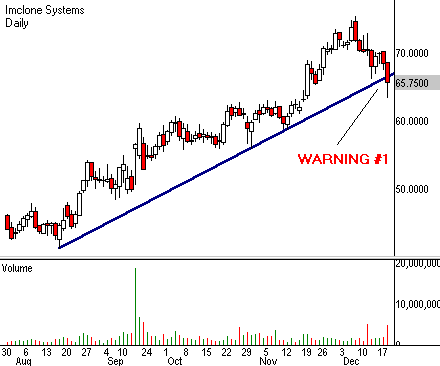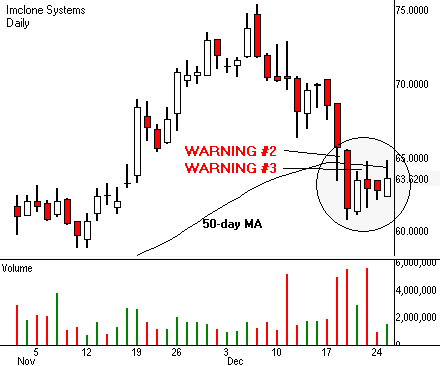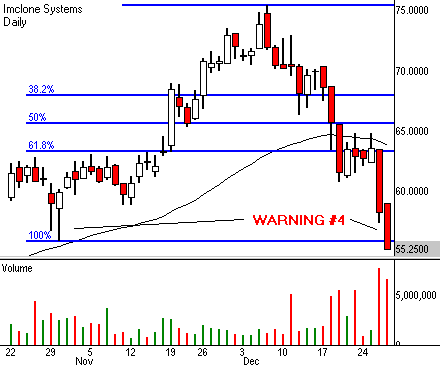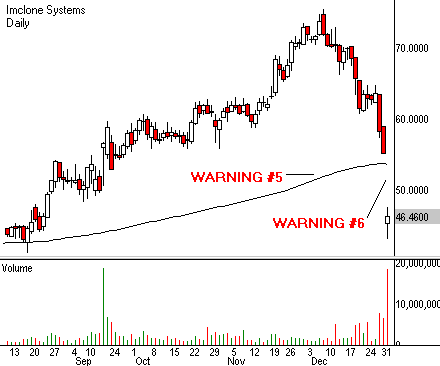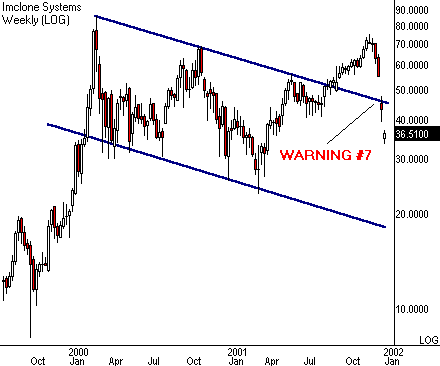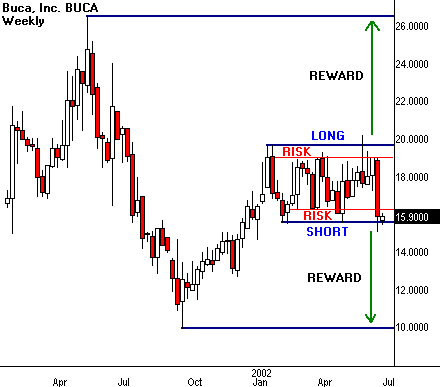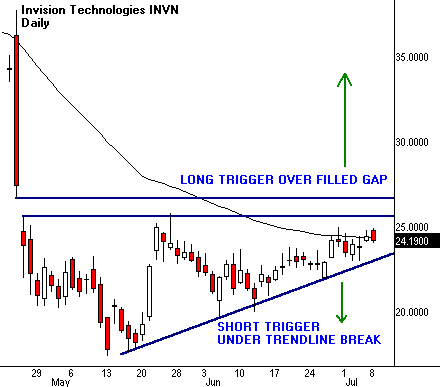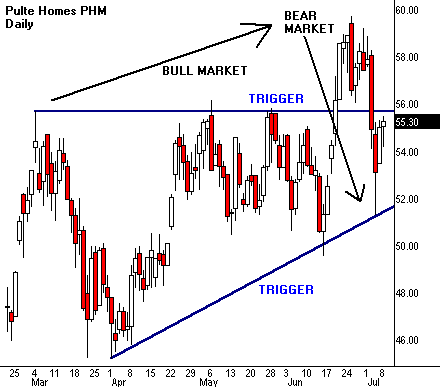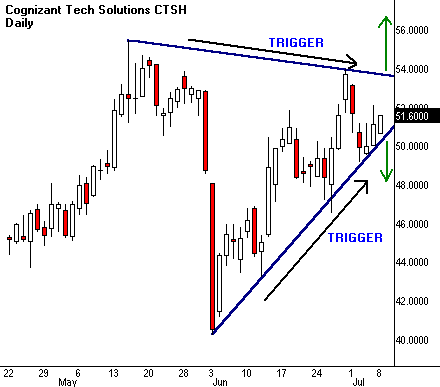Running Cup and Handle
The cup-and-handle (1) is typically a major reversal pattern that often precedes large rallies. It is formed when a stock sells off, bottoms, and then begins to rally, creating a "cup." After the rally, the stock drifts lower, forming the "handle" of the pattern. According to William O'Neil, who popularized the pattern, the best cup-and-handle candidates are stocks that already have staged a strong rally.
One way to measure the “strong rally” would be to use the 50-day moving average. As long as a stock remains above the 50-day moving average, it can be considered to be in an intermediate-term uptrend. Therefore, cup-and-handles that formed at or above the 50-day moving average are dubbed “running” as the market continues to “run” while the pattern is formed. The theory is that it combines a bottoming/correction formation with trend -- the best of both worlds.

Chart 1: Running Cup and Handle. Notice the cup forms at and above the 50-day moving average. Source: The Tradehard Guide to Conquering the Markets.
Expansion Pivots
As mentioned above and in previous articles, the 50-day simple moving average provides a point of reference for many institutions and large traders. Jeff Cooper has observed that “a stock will trade around its 50-day moving average for a period of time, and then without warning explode either to the upside or downside. This explosion often follows through for at least a few days…”(2). His strategy looks for a wide-range day that occurs in a stock that is trading at its 50-day moving average and then seeks to enter a position in the direction of that expansion.

Chart 2: Expansion Pivots. This set-up looks to enter on follow-through after wide-range movements at the 50-day moving average.
Holy Grail
In Street Smarts, Connors and Raschke showed that strongly-trending markets often retrace to the moving average before re-asserting themselves. If you think about it, this makes sense as markets often thrust/correct and then thrust again -- similar to the pullback pattern. Essentially the set-up looks for a strongly-trending market as measured by high ADX followed by a retracement to the 20-period exponential moving average. They jokingly dubbed this pattern the “Holy Grail”.

Chart 3: The Holy Grail. The pattern seeks to capitalize on a resumption of a strong trend as measured by a high ADX reading after retracements to the moving average.
Daylight Breakouts
Often, markets will trade around the moving average. They will have a slight rally (or selloff) and then return to the moving average. This is known as reversion to the mean (average) and has been discussed in previous articles. On occasion, the market will break free and begin to trend away from the moving average. While looking for a long-term trend-following system for the commodities markets, I notice that these trends or breakouts from the moving averages are often preceded by a period of at least two days, where the lows (for uptrends) or highs (for downtrends) fail to touch the moving average. This “gap” above and below the moving average was dubbed “daylight” by a fellow trader as you could see “daylight” in-between the price bar and the moving average. The original system, The 2/20-Day EMA Breakout System(3), used a 20-day exponential moving average and is described below in figure 1. Once the entry qualifications were met, a buy entry was placed above the two-bar high. Short sales are reversed. Setups for the pattern are shown in Chart 6, February 2000 Gold Comex.

Figure 1: The 2/20 EMA set-up. Source: Technical Analysis of Stocks and Commodities, December 1996 Issue.

Chart 4: February Comex Gold. Notice the 2/20 EMA Breakouts (or “Daylight” Breakouts) requires the market to trade above the two-bar high of the set-up for longs and below the two-bar low for shorts. If the market fails to pass these points then there is no trade.
Like most trend-following systems, Daylight Breakouts are prone to large drawdowns (losses to equity) when traded on a purely mechanical basis as markets only trend about 30% of the time. However, when used on a discretionary basis, combined with money management and/or additional technical indicators (i.e. a strong underlying trend) it can be a useful tool. Also, you might consider varying the lengths (and types) of moving averages used depending on your trading style. For instance, short-term traders may consider using a 10-period moving average whereas longer term traders may consider a 50-period moving average or longer.
Conclusion and Series Summary
In the first part of the series we defined the different types of moving averages. These included the simple, weighted and exponential moving averages. These different types of averages essentially behaved the same except in strong trends and breakouts when the weighted and exponential moving averages tended to “catch up” faster to current prices. In Part II, we looked at the characteristics of moving averages such as reversion-to-the-mean and the drop-off effect. We also looked at general uses which included support/resistance or reference points and using the slope of the moving average to measure trend. Finally, we showed more specific set-ups which seek to capitalize on these features.
So which moving average or set-up is best? It all boils down to personal preference and trading style. I encourage you to study the different types of moving averages and the above set-ups. Modify them to your liking or create your own methods.
By David Landry















 In a downtrend, the line is placed along the price highs. A close above this line tells traders the trend may be about to change direction. This is used as an entry signal. Where we draw the trend line is important because it could cost us money.
In a downtrend, the line is placed along the price highs. A close above this line tells traders the trend may be about to change direction. This is used as an entry signal. Where we draw the trend line is important because it could cost us money.
 Divergence signals give the trader an advantage by confirming an entry into a downtrend as it weakens and just before it turns into an up trend. It is also used to get out of an up trend as it weakens, and before it collapses into a downtrend. The divergence signal does not occur every time a trend changes, but when it does, it delivers a strong confirmation signal that a trend break is likely.
Divergence signals give the trader an advantage by confirming an entry into a downtrend as it weakens and just before it turns into an up trend. It is also used to get out of an up trend as it weakens, and before it collapses into a downtrend. The divergence signal does not occur every time a trend changes, but when it does, it delivers a strong confirmation signal that a trend break is likely.




















